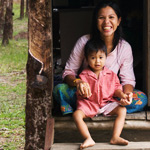Andaman Discoveries Blog
Tuesday, March 17, 2009
Gin Khao Reu Yang?
 Experiences in Thailand
Experiences in ThailandBy Leslie Welshimer
It began with an intense craving for American food – a meal of a tuna sandwich, fries and a salad.
As I was savoring my meal, another farang smirked and laughed as he walked by my table, mocking my choice of dinner. And, so it began. March 6 marked the beginning of a one-month pact to eat only local cuisine in Kuraburi.
Prior to living in Thailand, I too mocked the thought of travelers dining on Western food abroad. Then by week three in Thailand, it occurred to me that I had been a giant, judgmental hypocrite for mocking others.
| Week one of Western-food free month included a visit to Tung Dap village where we feasted on crab, squid and fresh coconut for a beverage. |
It had never occurred to me that the ability to get nearly any type of food, at any time, is a luxury. Yes, I realized, I had taken that delicious, juicy burrito, the size of a baby, for granted. Gorditos, please forgive me.
Other than a Gorditos-absent environment, what is different about eating in Thailand? For starters, Thai food is generally eaten with a fork and a spoon. The spoon is the star of the show, bringing the food to your mouth. The fork, held in the left hand, is used like a knife in Western cultures to push food into the spoon. Chopsticks are used rarely, primarily for the consumption of noodle soups.
Rice is a beloved food here. It is so beloved that the phrase for, “have you eaten yet,” is “gin khao reu yang" or “have you had rice yet.”
 |
| Delicious waffles are sold at the Kuraburi morning market. |
Food is eaten slowly, savored. The sharing of food with others is part of the fun. When eating with Thais, the concept of “my entrée” is uncommon.
What will you share? A Thai meal commonly contains a soup, a curry dish with condiments, a dip with accompanying fish and vegetables. A spiced salad often replaces the curry dish. The overarching key is a balance and harmony of tastes and textures.
 |
| Fresh fruit is a treat at area markets. |
Tables full of fresh fruit and vegetables are a common site. There are several varieties of ready-to-eat food, including a noodle bar where you choose your toppings, fish cakes, barbecue chicken, sticky rice, fried bananas, and on and on.
My favorite meal from the morning market is a hot coffee (10 baht) and two waffles (10 baht), purchased from separate vendors. The grand total is less than $1 for a scrumptious breakfast.
 |
| Pad med mamuang (cashew chicken) with a fresh fruit smoothie at Cucina Andaburi. |
One observation I quickly made in Thailand was there aren’t designated foods for different meals. I see people eating the same noodle dishes for breakfast as they have for dinner. Barbecued chicken is seen at the morning and night market.
As far as ordering food, I’ve found it’s useful to know how to say and understand numbers in Thai. It’s helpful to know a few words like the names of foods you like or don’t like. If all else fails, pointing with a smile, rubbing your belly or using a phrasebook works.
 |
| Som tam is served at this atmosphere-filled restaurant on stilts. |
(Note: These experiences are from Kuraburi. Food in other parts of Thailand may vary)
Labels: Kuraburi, Thai culture, Thai food
Comments:
<< Home
20180906 xiaoou
nobis jackets
air more uptempo
cheap nba jerseys
ralph lauren shirts
nike air max 97
supreme clothing uk
adidas yeezy boost
g-star jeans
ferragamo shoes
adidas y3 shoes
Post a Comment
nobis jackets
air more uptempo
cheap nba jerseys
ralph lauren shirts
nike air max 97
supreme clothing uk
adidas yeezy boost
g-star jeans
ferragamo shoes
adidas y3 shoes
Subscribe to Post Comments [Atom]
<< Home
Subscribe to Comments [Atom]







